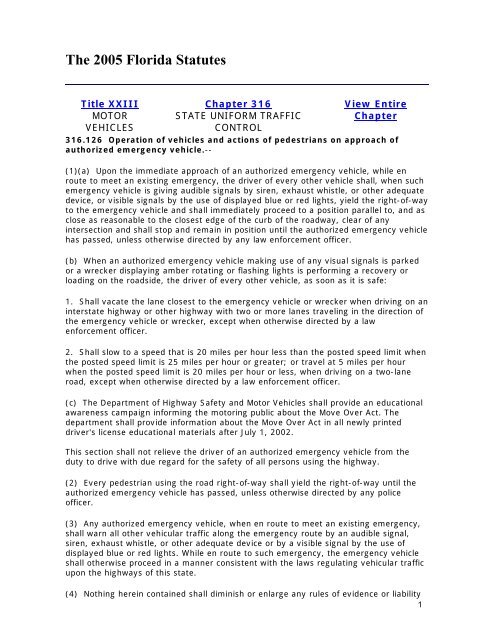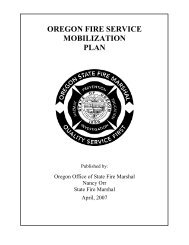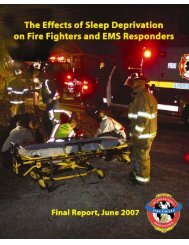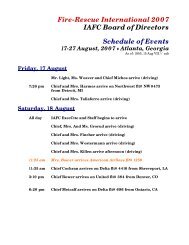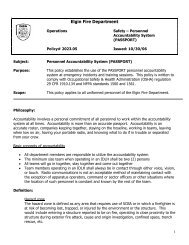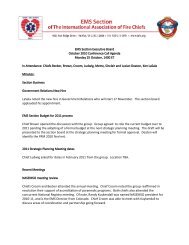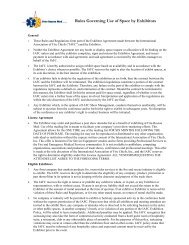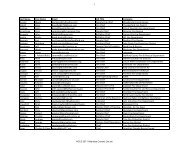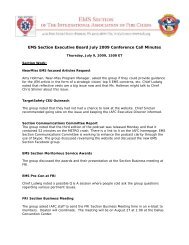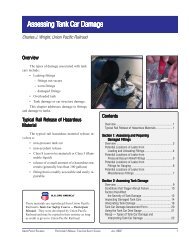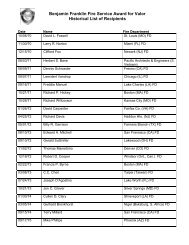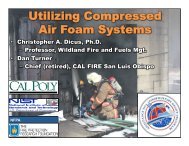The 2005 Florida Statutes - IAFC
The 2005 Florida Statutes - IAFC
The 2005 Florida Statutes - IAFC
Create successful ePaper yourself
Turn your PDF publications into a flip-book with our unique Google optimized e-Paper software.
<strong>The</strong> <strong>2005</strong> <strong>Florida</strong> <strong>Statutes</strong><br />
Title XXIII<br />
MOTOR<br />
VEHICLES<br />
Chapter 316<br />
STATE UNIFORM TRAFFIC<br />
CONTROL<br />
View Entire<br />
Chapter<br />
316.126 Operation of vehicles and actions of pedestrians on approach of<br />
authorized emergency vehicle.--<br />
(1)(a) Upon the immediate approach of an authorized emergency vehicle, while en<br />
route to meet an existing emergency, the driver of every other vehicle shall, when such<br />
emergency vehicle is giving audible signals by siren, exhaust whistle, or other adequate<br />
device, or visible signals by the use of displayed blue or red lights, yield the right-of-way<br />
to the emergency vehicle and shall immediately proceed to a position parallel to, and as<br />
close as reasonable to the closest edge of the curb of the roadway, clear of any<br />
intersection and shall stop and remain in position until the authorized emergency vehicle<br />
has passed, unless otherwise directed by any law enforcement officer.<br />
(b) When an authorized emergency vehicle making use of any visual signals is parked<br />
or a wrecker displaying amber rotating or flashing lights is performing a recovery or<br />
loading on the roadside, the driver of every other vehicle, as soon as it is safe:<br />
1. Shall vacate the lane closest to the emergency vehicle or wrecker when driving on an<br />
interstate highway or other highway with two or more lanes traveling in the direction of<br />
the emergency vehicle or wrecker, except when otherwise directed by a law<br />
enforcement officer.<br />
2. Shall slow to a speed that is 20 miles per hour less than the posted speed limit when<br />
the posted speed limit is 25 miles per hour or greater; or travel at 5 miles per hour<br />
when the posted speed limit is 20 miles per hour or less, when driving on a two-lane<br />
road, except when otherwise directed by a law enforcement officer.<br />
(c) <strong>The</strong> Department of Highway Safety and Motor Vehicles shall provide an educational<br />
awareness campaign informing the motoring public about the Move Over Act. <strong>The</strong><br />
department shall provide information about the Move Over Act in all newly printed<br />
driver's license educational materials after July 1, 2002.<br />
This section shall not relieve the driver of an authorized emergency vehicle from the<br />
duty to drive with due regard for the safety of all persons using the highway.<br />
(2) Every pedestrian using the road right-of-way shall yield the right-of-way until the<br />
authorized emergency vehicle has passed, unless otherwise directed by any police<br />
officer.<br />
(3) Any authorized emergency vehicle, when en route to meet an existing emergency,<br />
shall warn all other vehicular traffic along the emergency route by an audible signal,<br />
siren, exhaust whistle, or other adequate device or by a visible signal by the use of<br />
displayed blue or red lights. While en route to such emergency, the emergency vehicle<br />
shall otherwise proceed in a manner consistent with the laws regulating vehicular traffic<br />
upon the highways of this state.<br />
(4) Nothing herein contained shall diminish or enlarge any rules of evidence or liability<br />
1
in any case involving the operation of an emergency vehicle.<br />
(5) This section shall not operate to relieve the driver of an authorized emergency<br />
vehicle from the duty to drive with due regard for the safety of all persons using the<br />
highway.<br />
(6) A violation of this section is a noncriminal traffic infraction, punishable pursuant to<br />
chapter 318 as either a moving violation for infractions of subsection (1) or subsection<br />
(3), or as a pedestrian violation for infractions of subsection (2).<br />
History.--s. 1, ch. 71-135; s. 1, ch. 84-204; s. 122, ch. 99-248; s. 2, ch. 2002-217; s. 2, ch. 2004-20.<br />
Title XXVII<br />
RAILROADS AND OTHER REGULATED UTILITIES<br />
Chapter 351<br />
RAILROADS<br />
351.034 Railroad-highway grade crossings to be cleared for emergency<br />
vehicles.--Except for trains or equipment stopped due to mechanical failure where<br />
separation or movement is not possible, any train or equipment that has come to a<br />
complete stop and is blocking a railroad-highway grade crossing must be cut, separated,<br />
or moved to clear the crossing upon the approach of any emergency vehicle, which for<br />
the purpose of this law shall be:<br />
(1) An ambulance operated by public authority or by private persons;<br />
(2) A fire engine; or an emergency vehicle operated by power or electric companies; or<br />
(3) Any other vehicle when operated as an emergency vehicle, defined as one which is<br />
engaged in the saving of life, property, or responding to any other public peril; or<br />
(4) Emergency vehicles used as such by the Government of the United States; when<br />
upon the approach of such emergency vehicle, such vehicle gives due warning of its<br />
approach to such crossing by the sounding of sirens, flashing of lights, waving of flag, or<br />
any other warning sufficient to attract attention to such emergency vehicle; and<br />
thereupon the said train or equipment shall be cut and said crossing shall be cleared<br />
with all possible dispatch to permit the crossing and passing through of said emergency<br />
vehicle.<br />
History.--s. 4, ch. 67-309; s. 5, ch. 80-289; ss. 2, 3, ch. 81-318; ss. 12, 14, ch. 82-90; ss. 3, 5, 6, ch. 92-192; s.<br />
58, ch. 95-143; s. 143, ch. 99-13.<br />
2
Title XLVI<br />
CRIMES<br />
Chapter 843<br />
OBSTRUCTING JUSTICE<br />
843.16 Unlawful to install or transport radio equipment using assigned<br />
frequency of state or law enforcement officers; definitions; exceptions;<br />
penalties.--<br />
(1) A person, firm, or corporation may not install or transport in any motor vehicle or<br />
business establishment, except an emergency vehicle or crime watch vehicle as herein<br />
defined or a place established by municipal, county, state, or federal authority for<br />
governmental purposes, any frequency modulation radio receiving equipment so<br />
adjusted or tuned as to receive messages or signals on frequencies assigned by the<br />
Federal Communications Commission to police or law enforcement officers or fire rescue<br />
personnel of any city or county of the state or to the state or any of its agencies.<br />
Provided, nothing herein shall be construed to affect any radio station licensed by the<br />
Federal Communications System or to affect any recognized newspaper or news<br />
publication engaged in covering the news on a full-time basis or any alarm system<br />
contractor certified pursuant to part II of chapter 489, operating a central monitoring<br />
system.<br />
(2) As used in this section, the term:<br />
(a) "Emergency vehicle" shall specifically mean:<br />
1. Any motor vehicle used by any law enforcement officer or employee of any city, any<br />
county, the state, the Federal Bureau of Investigation, or the Armed Forces of the United<br />
States while on official business;<br />
2. Any fire department vehicle of any city or county of the state or any state fire<br />
department vehicle;<br />
3. Any motor vehicle designated as an emergency vehicle by the Department of<br />
Highway Safety and Motor Vehicles when said vehicle is to be assigned the use of<br />
frequencies assigned to the state;<br />
4. Any motor vehicle designated as an emergency vehicle by the sheriff or fire chief of<br />
any county in the state when said vehicle is to be assigned the use of frequencies<br />
assigned to the said county;<br />
5. Any motor vehicle designated as an emergency vehicle by the chief of police or fire<br />
chief of any city in the state when said vehicle is to be assigned the use of frequencies<br />
assigned to the said city.<br />
(b) "Crime watch vehicle" means any motor vehicle used by any person participating in<br />
a citizen crime watch or neighborhood watch program when such program and use are<br />
approved in writing by the appropriate sheriff or chief of police where the vehicle will be<br />
used and the vehicle is assigned the use of frequencies assigned to the county or city.<br />
Such approval shall be renewed annually.<br />
(3) This section shall not apply to any holder of a valid amateur radio operator or<br />
3
station license issued by the Federal Communications Commission or to any recognized<br />
newspaper or news publication engaged in covering the news on a full-time basis or any<br />
alarm system contractor certified pursuant to part II of chapter 489, operating a central<br />
monitoring system.<br />
(4) Any person, firm, or corporation violating any of the provisions of this section<br />
commits a misdemeanor of the first degree, punishable as provided in s. 775.082 or s.<br />
775.083.<br />
History.--ss. 1-4, ch. 26886, 1951; ss. 24, 35, ch. 69-106; s. 1049, ch. 71-136; s. 1, ch. 86-55; s. 1, ch. 90-62; s.<br />
95, ch. <strong>2005</strong>-164.<br />
Title XXIII<br />
MOTOR VEHICLES<br />
Chapter 316<br />
STATE UNIFORM TRAFFIC CONTROL<br />
316.3045 Operation of radios or other mechanical soundmaking devices or<br />
instruments in vehicles; exemptions.--<br />
(1) It is unlawful for any person operating or occupying a motor vehicle on a street or<br />
highway to operate or amplify the sound produced by a radio, tape player, or other<br />
mechanical soundmaking device or instrument from within the motor vehicle so that the<br />
sound is:<br />
(a) Plainly audible at a distance of 25 feet or more from the motor vehicle; or<br />
(b) Louder than necessary for the convenient hearing by persons inside the vehicle in<br />
areas adjoining churches, schools, or hospitals.<br />
(2) <strong>The</strong> provisions of this section shall not apply to any law enforcement motor vehicle<br />
equipped with any communication device necessary in the performance of law<br />
enforcement duties or to any emergency vehicle equipped with any communication device<br />
necessary in the performance of any emergency procedures.<br />
(3) <strong>The</strong> provisions of this section do not apply to motor vehicles used for business or<br />
political purposes, which in the normal course of conducting such business use<br />
soundmaking devices. <strong>The</strong> provisions of this subsection shall not be deemed to prevent<br />
local authorities, with respect to streets and highways under their jurisdiction and within<br />
the reasonable exercise of the police power, from regulating the time and manner in which<br />
such business may be operated.<br />
(4) <strong>The</strong> provisions of this section do not apply to the noise made by a horn or other<br />
warning device required or permitted by s. 316.271. <strong>The</strong> Department of Highway Safety<br />
and Motor Vehicles shall promulgate rules defining "plainly audible" and establish<br />
standards regarding how sound should be measured by law enforcement personnel who<br />
enforce the provisions of this section.<br />
(5) A violation of this section is a noncriminal traffic infraction, punishable as a<br />
nonmoving violation as provided in chapter 318.<br />
History.--s. 1, ch. 90-256; s. 220, ch. 99-248; s. 9, ch. <strong>2005</strong>-164.<br />
4
Title XXIII<br />
Chapter 316<br />
MOTOR VEHICLES STATE UNIFORM TRAFFIC CONTROL<br />
316.271 Horns and warning devices.--<br />
(1) Every motor vehicle when operated upon a highway shall be equipped with a horn in<br />
good working order and capable of emitting sound audible under normal conditions from<br />
a distance of not less than 200 feet.<br />
(2) No horn or other warning device shall emit an unreasonably loud or harsh sound or<br />
a whistle.<br />
(3) <strong>The</strong> driver of a motor vehicle shall, when reasonably necessary to ensure safe<br />
operation, give audible warning with his or her horn, but shall not otherwise use such<br />
horn when upon a highway.<br />
(4) No vehicle shall be equipped with, nor shall any person use upon a vehicle, any<br />
siren, whistle, or bell, except as otherwise permitted in this section.<br />
(5) It is permissible but not required that any vehicle be equipped with a theft alarm<br />
signal device which is so arranged that it cannot be used by the driver as an ordinary<br />
warning signal.<br />
(6) Every authorized emergency vehicle shall be equipped with a siren, whistle, or bell<br />
capable of emitting sound audible under normal conditions from a distance of not less<br />
than 500 feet and of a type approved by the department, but such siren, whistle, or bell<br />
shall not be used except when the vehicle is operated in response to an emergency call<br />
or in the immediate pursuit of an actual or suspected violator of the law, in which event<br />
the driver of the vehicle shall sound the siren, whistle, or bell when reasonably<br />
necessary to warn pedestrians and other drivers of the approach thereof.<br />
(7) Notwithstanding the other provisions of this section, a trolley may be equipped with<br />
a bell, and the bell is not required to be used only as a warning device. As used in this<br />
subsection, the term "trolley" includes any bus which resembles a streetcar, which is<br />
powered by overhead electric wires or is self-propelled, and which is used primarily as a<br />
public conveyance.<br />
(8) A violation of this section is a noncriminal traffic infraction, punishable as a<br />
nonmoving violation as provided in chapter 318.<br />
History.--s. 1, ch. 71-135; s. 4, ch. 86-36; s. 1, ch. 88-91; s. 325, ch. 95-148; s. 203, ch. 99-248.<br />
5
Title XXIII<br />
MOTOR VEHICLES<br />
Chapter 316<br />
STATE UNIFORM TRAFFIC CONTROL<br />
316.2025 Following fire apparatus prohibited.--No driver of any vehicle other than<br />
an authorized emergency vehicle on official business shall follow any fire apparatus<br />
traveling in response to a fire alarm closer than 500 feet or drive into or park such<br />
vehicle within the block where fire apparatus has stopped in answer to a fire alarm. A<br />
violation of this section is a noncriminal traffic infraction, punishable pursuant to chapter<br />
318 as a moving violation for following too close to a fire apparatus or as a nonmoving<br />
violation for parking near a fire apparatus.<br />
History.--s. 1, ch. 71-135; s. 1, ch. 76-31; s. 155, ch. 99-248.<br />
Note.--Former s. 316.095.<br />
Title XXIX<br />
PUBLIC<br />
HEALTH<br />
401.281 Drivers.--<br />
Chapter 401<br />
MEDICAL TELECOMMUNICATIONS AND<br />
TRANSPORTATION<br />
(1) Each licensee is responsible for assuring that its vehicles are driven only by trained,<br />
experienced, and otherwise qualified personnel. <strong>The</strong> licensee must, at a minimum,<br />
document that each of its drivers:<br />
(a) Is at least 18 years of age;<br />
(b) Certifies under oath that he or she is not addicted to alcohol or any controlled<br />
substance;<br />
(c) Certifies under oath that he or she is free from any physical or mental defect or<br />
disease that might impair his or her ability to drive an ambulance;<br />
(d) Has not, within the past 3 years, been convicted of reckless driving or driving under<br />
the influence of alcohol or controlled substances and has not had a driver's license<br />
suspended under the point system provided for in chapter 322;<br />
(e) Possesses a valid driver's license issued under chapter 322, is trained in the safe<br />
operation of emergency vehicles, and has completed an emergency vehicle operator's<br />
course or the reasonable equivalent as approved by the department; however, this<br />
paragraph applies only to a driver of a land vehicle;<br />
(f) Possesses a valid American Red Cross or National Safety Council standard first aid<br />
course card or its equivalent; and<br />
(g) Possesses a valid American Red Cross or American Heart Association<br />
6
cardiopulmonary resuscitation card.<br />
(2) <strong>The</strong> department shall periodically inspect licensees for verification of compliance<br />
with this section. Services that are unable to verify compliance are subject to disciplinary<br />
action as provided in this part.<br />
History.--ss. 11, 25, ch. 82-402; ss. 8, 13, ch. 83-196; s. 10, ch. 84-317; s. 60, ch. 86-220; s. 56, ch. 89-282; ss.<br />
10, 36, ch. 92-78; s. 796, ch. 95-148.<br />
Title XXIII<br />
MOTOR VEHICLES<br />
322.01 Definitions.--As used in this chapter:<br />
Chapter 322<br />
DRIVERS' LICENSES<br />
(1) "Actual weight" means the weight of a motor vehicle or motor vehicle combination<br />
plus the weight of the load carried on it, as determined at a fixed scale operated by the<br />
state or as determined by use of a portable scale operated by a law enforcement officer.<br />
(2) "Alcohol" means any substance containing any form of alcohol including, but not<br />
limited to, ethanol, methanol, propanol, and isopropanol.<br />
(3) "Alcohol concentration" means:<br />
(a) <strong>The</strong> number of grams of alcohol per 100 milliliters of blood;<br />
(b) <strong>The</strong> number of grams of alcohol per 210 liters of breath; or<br />
(c) <strong>The</strong> number of grams of alcohol per 67 milliliters of urine.<br />
(4) "Authorized emergency vehicle" means a vehicle that is equipped with extraordinary<br />
audible and visual warning devices, that is authorized by s. 316.2397 to display red or<br />
blue lights, and that is on call to respond to emergencies. <strong>The</strong> term includes, but is not<br />
limited to, ambulances, law enforcement vehicles, fire trucks, and other rescue vehicles.<br />
<strong>The</strong> term does not include wreckers, utility trucks, or other vehicles that are used only<br />
incidentally for emergency purposes.<br />
(5) "Cancellation" means the act of declaring a driver's license void and terminated.<br />
(6) "Color photographic driver's license" means a color photograph of a completed<br />
driver's license form meeting the requirements prescribed in s. 322.14.<br />
(7) "Commercial driver's license" means a Class A, Class B, or Class C driver's license<br />
issued in accordance with the requirements of this chapter.<br />
(8) "Commercial motor vehicle" means any motor vehicle or motor vehicle combination<br />
used on the streets or highways, which:<br />
(a) Has a gross vehicle weight rating of 26,001 pounds or more;<br />
7
(b) Is designed to transport more than 15 persons, including the driver; or<br />
(c) Is transporting hazardous materials and is required to be placarded in accordance<br />
with Title 49 C.F.R. part 172, subpart F.<br />
(9) "Controlled substance" means any substance classified as such under 21 U.S.C. s.<br />
802(6), Schedules I-V of Title 21 C.F.R. part 1308, or chapter 893.<br />
(10)(a) "Conviction" means a conviction of an offense relating to the operation of motor<br />
vehicles on highways which is a violation of this chapter or any other such law of this state<br />
or any other state, including an admission or determination of a noncriminal traffic<br />
infraction pursuant to s. 318.14, or a judicial disposition of an offense committed under<br />
any federal law substantially conforming to the aforesaid state statutory provisions.<br />
(b) Notwithstanding any other provisions of this chapter, the definition of "conviction"<br />
provided in 49 C.F.R. part 383.5 applies to offenses committed in a commercial motor<br />
vehicle.<br />
(11) "Court" means any tribunal in this state or any other state, or any federal tribunal,<br />
which has jurisdiction over any civil, criminal, traffic, or administrative action.<br />
(12) "Declared weight" means the maximum loaded weight declared for purposes of<br />
registration, pursuant to chapter 320.<br />
(13) "Department" means the Department of Highway Safety and Motor Vehicles acting<br />
directly or through its duly authorized representatives.<br />
(14) "Disqualification" means a prohibition, other than an out-of-service order, that<br />
precludes a person from driving a commercial motor vehicle.<br />
(15) "Drive" means to operate or be in actual physical control of a motor vehicle in any<br />
place open to the general public for purposes of vehicular traffic.<br />
(16) "Driver's license" means a certificate which, subject to all other requirements of law,<br />
authorizes an individual to drive a motor vehicle.<br />
(17) "Endorsement" means a special authorization which permits a driver to drive certain<br />
types of vehicles or to transport certain types of property or a certain number of<br />
passengers.<br />
(18) "Farmer" means a person who grows agricultural products, including aquacultural,<br />
horticultural, and forestry products, and, except as provided herein, employees of such<br />
persons. <strong>The</strong> term does not include employees whose primary purpose of employment is<br />
the operation of motor vehicles.<br />
(19) "Farm tractor" means a motor vehicle designed and used primarily as a farm<br />
implement for drawing plows, mowing machines, and other implements of husbandry.<br />
(20) "Felony" means any offense under state or federal law that is punishable by death or<br />
by a term of imprisonment exceeding 1 year.<br />
(21) "Foreign jurisdiction" means any jurisdiction other than a state of the United States.<br />
8
(22) "Gross vehicle weight rating" means the value specified by the manufacturer as the<br />
maximum loaded weight of a single, combination, or articulated vehicle.<br />
(23) "Hazardous materials" has the meaning such term has under s. 103 of the<br />
Hazardous Materials Transportation Act.<br />
(24) "Medical examiner's certificate" means a document substantially in accordance with<br />
the requirements of Title 49 C.F.R. s. 391.43.<br />
(25) "Motorcycle" means a motor vehicle powered by a motor with a displacement of<br />
more than 50 cubic centimeters, having a seat or saddle for the use of the rider, and<br />
designed to travel on not more than three wheels in contact with the ground, but<br />
excluding a tractor or moped.<br />
(26) "Motor vehicle" means any self-propelled vehicle, including a motor vehicle<br />
combination, not operated upon rails or guideway, excluding vehicles moved solely by<br />
human power, motorized wheelchairs, and motorized bicycles as defined in s. 316.003.<br />
(27) "Motor vehicle combination" means a motor vehicle operated in conjunction with one<br />
or more other vehicles.<br />
(28) "Narcotic drugs" means coca leaves, opium, isonipecaine, cannabis, and every<br />
substance neither chemically nor physically distinguishable from them, and any and all<br />
derivatives of same, and any other drug to which the narcotics laws of the United States<br />
apply, and includes all drugs and derivatives thereof known as barbiturates.<br />
(29) "Out-of-service order" means a prohibition issued by an authorized local, state, or<br />
Federal Government official which precludes a person from driving a commercial motor<br />
vehicle for a period of 72 hours or less.<br />
(30) "Owner" means the person who holds the legal title to a vehicle. However, if a<br />
vehicle is the subject of an agreement for the conditional sale or lease thereof with the<br />
right of purchase upon performance of the conditions stated in the agreement and with an<br />
immediate right of possession vested in the conditional vendee or lessee, or if a<br />
mortgagor of a vehicle is entitled to possession, such conditional vendee, lessee, or<br />
mortgagor is the owner for the purpose of this chapter.<br />
(31) "Passenger vehicle" means a motor vehicle designed to transport more than 15<br />
persons, including the driver, or a school bus designed to transport more than 15 persons,<br />
including the driver.<br />
(32) "Permit" means a document authorizing the temporary operation of a motor vehicle<br />
within this state subject to conditions established in this chapter.<br />
(33) "Resident" means a person who has his or her principal place of domicile in this state<br />
for a period of more than 6 consecutive months, has registered to vote, has made a<br />
statement of domicile pursuant to s. 222.17, or has filed for homestead tax exemption on<br />
property in this state.<br />
(34) "Restriction" means a prohibition against operating certain types of motor vehicles or<br />
a requirement that a driver comply with certain conditions when driving a motor vehicle.<br />
9
(35) "Revocation" means the termination of a licensee's privilege to drive.<br />
(36) "School bus" means a motor vehicle that is designed to transport more than 15<br />
persons, including the driver, and that is used to transport students to and from a public<br />
or private school or in connection with school activities, but does not include a bus<br />
operated by a common carrier in the urban transportation of school children. <strong>The</strong> term<br />
"school" includes all preelementary, elementary, secondary, and postsecondary schools.<br />
(37) "State" means a state or possession of the United States, and, for the purposes of<br />
this chapter, includes the District of Columbia.<br />
(38) "Street or highway" means the entire width between the boundary lines of a way or<br />
place if any part of that way or place is open to public use for purposes of vehicular traffic.<br />
(39) "Suspension" means the temporary withdrawal of a licensee's privilege to drive a<br />
motor vehicle.<br />
(40) "Tank vehicle" means a vehicle that is designed to transport any liquid or gaseous<br />
material within a tank either permanently or temporarily attached to the vehicle, if such<br />
tank has a designed capacity of 1,000 gallons or more.<br />
(41) "United States" means the 50 states and the District of Columbia.<br />
(42) "Vehicle" means every device in, upon, or by which any person or property is or may<br />
be transported or drawn upon a public highway or operated upon rails or guideway,<br />
except a bicycle, motorized wheelchair, or motorized bicycle.<br />
History.--s. 13, ch. 19551, 1939; CGL 1940 Supp. 4151(627); s. 13, ch. 20451, 1941; s. 1, ch. 29721, 1955; s. 1, ch.<br />
61-457; s. 1, ch. 63-156; s. 1, ch. 65-496; s. 1, ch. 67-242; s. 1, ch. 67-304; s. 1, ch. 67-346; ss. 24, 35, ch. 69-106;<br />
s. 99, ch. 71-377; s. 5, ch. 76-286; s. 5, ch. 78-353; s. 1, ch. 78-394; s. 1, ch. 81-3; s. 1, ch. 81-188; s. 17, ch. 83-<br />
218; s. 8, ch. 85-81; s. 16, ch. 87-161; s. 3, ch. 89-282; s. 3, ch. 90-230; s. 70, ch. 94-306; s. 925, ch. 95-148; s. 11,<br />
ch. 95-247; s. 31, ch. 95-333; s. 8, ch. 96-247; s. 67, ch. <strong>2005</strong>-164.<br />
Title XXIII<br />
MOTOR<br />
VEHICLES<br />
316.304 Wearing of headsets.--<br />
Chapter 316<br />
STATE UNIFORM TRAFFIC<br />
CONTROL<br />
View Entire<br />
Chapter<br />
(1) No person shall operate a vehicle while wearing a headset, headphone, or other<br />
listening device, other than a hearing aid or instrument for the improvement of defective<br />
human hearing.<br />
(2) This section does not apply to:<br />
(a) Any law enforcement officer equipped with any communication device necessary in<br />
performing his or her assigned duties or to any emergency vehicle operator equipped<br />
with any ear protection device.<br />
(b) Any applicant for a license to operate a motorcycle while taking the examination<br />
10
equired by s. 322.12(5).<br />
(c) Any person operating a motorcycle who is using a headset that is installed in a<br />
helmet and worn so as to prevent the speakers from making direct contact with the<br />
user's ears so that the user can hear surrounding sounds.<br />
(d) Any person using a headset in conjunction with a cellular telephone that only<br />
provides sound through one ear and allows surrounding sounds to be heard with the<br />
other ear.<br />
(e) Any person using a headset in conjunction with communicating with the central<br />
base operation that only provides sound through one ear and allows surrounding sounds<br />
to be heard with the other ear.<br />
(3) <strong>The</strong> Department of Highway Safety and Motor Vehicles shall promulgate, by<br />
administrative rule, standards and specifications for headset equipment the use of which<br />
is permitted under this section. <strong>The</strong> department shall inspect and review all such devices<br />
submitted to it and shall publish a list by name and type of approved equipment.<br />
(4) A violation of this section is a noncriminal traffic infraction, punishable as a<br />
nonmoving violation as provided in chapter 318.<br />
History.--s. 1, ch. 73-4; s. 1, ch. 76-31; s. 8, ch. 83-228; s. 4, ch. 84-284; s. 2, ch. 85-329; s. 24, ch. 87-161; s. 3,<br />
ch. 88-405; s. 3, ch. 92-18; s. 24, ch. 95-143; s. 327, ch. 95-148; s. 219, ch. 99-248; s. 105, ch. 2002-20.<br />
Note.--Former s. 316.0285.<br />
Title XXIII<br />
Chapter 316<br />
MOTOR VEHICLES STATE UNIFORM TRAFFIC CONTROL<br />
316.1975 Unattended motor vehicle.--<br />
(1) A person driving or in charge of any motor vehicle may not permit it to stand<br />
unattended without first stopping the engine, locking the ignition, and removing the key.<br />
A vehicle may not be permitted to stand unattended upon any perceptible grade without<br />
stopping the engine and effectively setting the brake thereon and turning the front<br />
wheels to the curb or side of the street. A violation of this section is a noncriminal traffic<br />
infraction, punishable as a nonmoving violation as provided in chapter 318.<br />
(2) This section does not apply to the operator of:<br />
(a) An authorized emergency vehicle while in the performance of official duties and the<br />
vehicle is equipped with an activated antitheft device that prohibits the vehicle from<br />
being driven;<br />
(b) A licensed delivery truck or other delivery vehicle while making deliveries; or<br />
(c) A solid waste or recovered materials collection vehicle while collecting such items.<br />
11
History.--s. 1, ch. 71-135; s. 1, ch. 76-31; ss. 3, 148, ch. 99-248; s. 103, ch. 2002-20; s. 2, ch. 2002-23.<br />
Note.--Former s. 316.097.<br />
Title XXIII<br />
Chapter 316<br />
MOTOR VEHICLES STATE UNIFORM TRAFFIC CONTROL<br />
316.1974 Funeral procession right-of-way and liability.--<br />
(1) DEFINITIONS.--<br />
(a) "Funeral director" and "funeral establishment" shall have the same meaning as set<br />
forth in s. 497.005.<br />
(b) "Funeral procession" means two or more vehicles accompanying the body of a<br />
deceased person, or traveling to the church, chapel, or other location at which the<br />
funeral service is to be held, in the daylight hours, including a funeral lead vehicle or a<br />
funeral escort vehicle.<br />
(c) "Funeral lead vehicle" means any authorized law enforcement or non-law<br />
enforcement motor vehicle properly equipped pursuant to subsection (2) or a funeral<br />
escort vehicle being used to lead and facilitate the movement of a funeral procession. A<br />
funeral hearse may serve as a funeral lead vehicle.<br />
(d) "Funeral escort" means a person or entity that provides escort services for funeral<br />
processions, including law enforcement personnel and agencies.<br />
(e) "Funeral escort vehicle" means any motor vehicle that is properly equipped pursuant<br />
to subsection (2) and which escorts a funeral procession.<br />
(2) EQUIPMENT.--<br />
(a) All non-law enforcement funeral escort vehicles and funeral lead vehicles shall be<br />
equipped with at least one lighted circulation lamp exhibiting an amber or purple light or<br />
lens visible under normal atmospheric conditions for a distance of 500 feet from the<br />
front of the vehicle. Flashing amber or purple lights may be used only when such<br />
vehicles are used in a funeral procession.<br />
(b) Any law enforcement funeral escort vehicle may be equipped with red, blue, or<br />
amber flashing lights which meet the criteria established in paragraph (a).<br />
(3) FUNERAL PROCESSION RIGHT-OF-WAY; FUNERAL ESCORT VEHICLES; FUNERAL<br />
LEAD VEHICLES.--<br />
(a) Regardless of any traffic control device or right-of-way provisions prescribed by<br />
state or local ordinance, pedestrians and operators of all vehicles, except as stated in<br />
paragraph (c), shall yield the right-of-way to any vehicle which is part of a funeral<br />
12
procession being led by a funeral escort vehicle or a funeral lead vehicle.<br />
(b) When the funeral lead vehicle lawfully enters an intersection, either by reason of a<br />
traffic control device or at the direction of law enforcement personnel, the remaining<br />
vehicles in the funeral procession may follow through the intersection regardless of any<br />
traffic control devices or right-of-way provisions prescribed by state or local law.<br />
(c) Funeral processions shall have the right-of-way at intersections regardless of traffic<br />
control devices, subject to the following conditions and exceptions:<br />
1. Operators of vehicles in a funeral procession shall yield the right-of-way to an<br />
approaching emergency vehicle giving an audible or visible signal.<br />
2. Operators of vehicles in a funeral procession shall yield the right-of-way when<br />
directed to do so by a police officer.<br />
3. Operators of vehicles in a funeral procession must exercise due care when<br />
participating in a funeral procession.<br />
(4) DRIVING IN PROCESSION.--<br />
(a) All vehicles comprising a funeral procession shall follow the preceding vehicle in the<br />
funeral procession as closely as is practical and safe.<br />
(b) Any ordinance, law, or regulation stating that motor vehicles shall be operated to<br />
allow sufficient space enabling any other vehicle to enter and occupy such space without<br />
danger shall not be applicable to vehicles in a funeral procession.<br />
(c) Each vehicle which is part of a funeral procession shall have its headlights, either<br />
high or low beam, and tail lights lighted and may also use the flashing hazard lights if<br />
the vehicle is so equipped.<br />
(5) LIABILITY.--<br />
(a) Liability for any death, personal injury, or property damage suffered on or after<br />
October 1, 1997, by any person in a funeral procession shall not be imposed upon the<br />
funeral director or funeral establishment or their employees or agents unless such<br />
death, personal injury, or property damage is proximately caused by the negligent or<br />
intentional act of an employee or agent of the funeral director or funeral establishment.<br />
(b) A funeral director, funeral establishment, funeral escort, or other participant that<br />
leads, organizes, or participates in a funeral procession in accordance with this section<br />
shall be presumed to have acted with reasonable care.<br />
(c) Except for a grossly negligent or intentional act by a funeral director or funeral<br />
establishment, there shall be no liability on the part of a funeral director or funeral<br />
establishment for failing, on or after October 1, 1997, to use reasonable care in the<br />
planning or selection of the route to be followed by the funeral procession.<br />
(6) VIOLATIONS.--A violation of this section is a noncriminal traffic infraction,<br />
punishable pursuant to chapter 318 as a nonmoving violation for infractions of<br />
subsection (2), a pedestrian violation for infractions of subsection (3), or as a moving<br />
violation for infractions of subsection (3) or subsection (4) if the infraction resulted from<br />
13
the operation of a vehicle.<br />
History.--s. 1, ch. 71-135; s. 1, ch. 76-31; s. 14, ch. 97-300; s. 147, ch. 99-248; s. 136, ch. 2004-301; s. 1, ch.<br />
<strong>2005</strong>-155.<br />
Note.--Former s. 316.162.<br />
Title XXIII<br />
MOTOR VEHICLES<br />
Chapter 316<br />
STATE UNIFORM TRAFFIC CONTROL<br />
316.1964 Exemption of vehicles transporting certain persons who have<br />
disabilities from payment of parking fees and penalties.--<br />
(1) A state agency, county, municipality, or any agency thereof, may not exact any fee<br />
for parking on the public streets or highways or in any metered parking space from the<br />
driver of a vehicle that displays a disabled parking permit or a license plate issued under<br />
s. 316.1958 or s. 320.0848 or a license plate issued under s. 320.084, s. 320.0842, s.<br />
320.0843, or s. 320.0845 if the vehicle is transporting the person who has a disability<br />
and to whom the disabled parking permit or license plate was issued.<br />
(2) <strong>The</strong> driver of a vehicle that is parked as provided in subsection (1) may not be<br />
penalized for parking, except in clearly defined bus loading zones, fire zones, or access<br />
aisles adjacent to the parking spaces for persons who have disabilities, or in areas<br />
posted as "No Parking" zones or as emergency vehicle zones, or for parking in excess of<br />
the posted time limits.<br />
(3) Notwithstanding subsection (1), when a state, county, or municipal parking facility<br />
or lot is being used in connection with an event at a convention center, cruise-port<br />
terminal, sports stadium, sports arena, coliseum, or auditorium, the parking facility may<br />
charge a person whose vehicle displays such a parking permit a parking fee in the same<br />
manner and amount as it charges other persons.<br />
(4) A parking facility that restricts the number of consecutive days that a vehicle may<br />
be parked may impose that same restriction on a vehicle that displays a disabled<br />
parking permit issued to a person who has a disability.<br />
(5) Notwithstanding subsection (1), when an on-street parking meter restricts the<br />
duration of time that a vehicle may be parked, a vehicle properly displaying a disabled<br />
parking permit is allowed a maximum of 4 hours at no charge; however, local<br />
governments may extend such time by local ordinance.<br />
(6) A parking facility that leases a parking space for a duration that exceeds 1 week is<br />
not required to reduce the fee for a lessee who is disabled.<br />
(7) An airport that owns, operates, or leases parking facilities, or any other parking<br />
facilities that are used for the purpose of air travel, may charge for parking vehicles that<br />
display a disabled parking permit or license tag issued under s. 316.1958, s. 320.084, s.<br />
320.0842, s. 320.0843, s. 320.0845, or s. 320.0848. However, the governing body of<br />
each publicly owned or publicly operated airport must grant free parking to any vehicle<br />
with specialized equipment, such as ramps, lifts, or foot or hand controls, or for<br />
utilization by a person who has a disability or whose vehicle is displaying the <strong>Florida</strong> Toll<br />
14
Exemption permit.<br />
(8) Notwithstanding subsection (1), a county, municipality, or any agency thereof may<br />
charge for parking in a facility or lot that provides timed parking spaces any vehicle that<br />
displays a disabled parking permit, except that any vehicle with specialized equipment,<br />
such as ramps, lifts, or foot or hand controls, for use by a person who has a disability, or<br />
any vehicle that is displaying the <strong>Florida</strong> Toll Exemption permit, is exempt from any<br />
parking fees.<br />
History.--s. 1, ch. 71-135; s. 1, ch. 76-31; s. 1, ch. 77-83; s. 3, ch. 79-82; s. 23, ch. 90-330; s. 5, ch. 96-200; s. 3,<br />
ch. 98-202.<br />
Note.--Former s. 316.163.<br />
Title XXIII<br />
MOTOR VEHICLES<br />
Chapter 316<br />
STATE UNIFORM TRAFFIC CONTROL<br />
316.1932 Tests for alcohol, chemical substances, or controlled substances;<br />
implied consent; refusal.--<br />
(1)(a)1.a. Any person who accepts the privilege extended by the laws of this state of<br />
operating a motor vehicle within this state is, by so operating such vehicle, deemed to<br />
have given his or her consent to submit to an approved chemical test or physical test<br />
including, but not limited to, an infrared light test of his or her breath for the purpose of<br />
determining the alcoholic content of his or her blood or breath if the person is lawfully<br />
arrested for any offense allegedly committed while the person was driving or was in<br />
actual physical control of a motor vehicle while under the influence of alcoholic<br />
beverages. <strong>The</strong> chemical or physical breath test must be incidental to a lawful arrest and<br />
administered at the request of a law enforcement officer who has reasonable cause to<br />
believe such person was driving or was in actual physical control of the motor vehicle<br />
within this state while under the influence of alcoholic beverages. <strong>The</strong> administration of<br />
a breath test does not preclude the administration of another type of test. <strong>The</strong> person<br />
shall be told that his or her failure to submit to any lawful test of his or her breath will<br />
result in the suspension of the person's privilege to operate a motor vehicle for a period<br />
of 1 year for a first refusal, or for a period of 18 months if the driving privilege of such<br />
person has been previously suspended as a result of a refusal to submit to such a test or<br />
tests, and shall also be told that if he or she refuses to submit to a lawful test of his or<br />
her breath and his or her driving privilege has been previously suspended for a prior<br />
refusal to submit to a lawful test of his or her breath, urine, or blood, he or she commits<br />
a misdemeanor in addition to any other penalties. <strong>The</strong> refusal to submit to a chemical or<br />
physical breath test upon the request of a law enforcement officer as provided in this<br />
section is admissible into evidence in any criminal proceeding.<br />
b. Any person who accepts the privilege extended by the laws of this state of operating<br />
a motor vehicle within this state is, by so operating such vehicle, deemed to have given<br />
his or her consent to submit to a urine test for the purpose of detecting the presence of<br />
chemical substances as set forth in s. 877.111 or controlled substances if the person is<br />
lawfully arrested for any offense allegedly committed while the person was driving or<br />
was in actual physical control of a motor vehicle while under the influence of chemical<br />
substances or controlled substances. <strong>The</strong> urine test must be incidental to a lawful arrest<br />
and administered at a detention facility or any other facility, mobile or otherwise, which<br />
15
is equipped to administer such tests at the request of a law enforcement officer who has<br />
reasonable cause to believe such person was driving or was in actual physical control of<br />
a motor vehicle within this state while under the influence of chemical substances or<br />
controlled substances. <strong>The</strong> urine test shall be administered at a detention facility or any<br />
other facility, mobile or otherwise, which is equipped to administer such test in a<br />
reasonable manner that will ensure the accuracy of the specimen and maintain the<br />
privacy of the individual involved. <strong>The</strong> administration of a urine test does not preclude<br />
the administration of another type of test. <strong>The</strong> person shall be told that his or her failure<br />
to submit to any lawful test of his or her urine will result in the suspension of the<br />
person's privilege to operate a motor vehicle for a period of 1 year for the first refusal,<br />
or for a period of 18 months if the driving privilege of such person has been previously<br />
suspended as a result of a refusal to submit to such a test or tests, and shall also be told<br />
that if he or she refuses to submit to a lawful test of his or her urine and his or her<br />
driving privilege has been previously suspended for a prior refusal to submit to a lawful<br />
test of his or her breath, urine, or blood, he or she commits a misdemeanor in addition<br />
to any other penalties. <strong>The</strong> refusal to submit to a urine test upon the request of a law<br />
enforcement officer as provided in this section is admissible into evidence in any criminal<br />
proceeding.<br />
2. <strong>The</strong> Alcohol Testing Program within the Department of Law Enforcement is<br />
responsible for the regulation of the operation, inspection, and registration of breath test<br />
instruments utilized under the driving and boating under the influence provisions and<br />
related provisions located in this chapter and chapters 322 and 327. <strong>The</strong> program is<br />
responsible for the regulation of the individuals who operate, inspect, and instruct on the<br />
breath test instruments utilized in the driving and boating under the influence provisions<br />
and related provisions located in this chapter and chapters 322 and 327. <strong>The</strong> program is<br />
further responsible for the regulation of blood analysts who conduct blood testing to be<br />
utilized under the driving and boating under the influence provisions and related<br />
provisions located in this chapter and chapters 322 and 327. <strong>The</strong> program shall:<br />
a. Establish uniform criteria for the issuance of permits to breath test operators, agency<br />
inspectors, instructors, blood analysts, and instruments.<br />
b. Have the authority to permit breath test operators, agency inspectors, instructors,<br />
blood analysts, and instruments.<br />
c. Have the authority to discipline and suspend, revoke, or renew the permits of breath<br />
test operators, agency inspectors, instructors, blood analysts, and instruments.<br />
d. Establish uniform requirements for instruction and curricula for the operation and<br />
inspection of approved instruments.<br />
e. Have the authority to specify one approved curriculum for the operation and<br />
inspection of approved instruments.<br />
f. Establish a procedure for the approval of breath test operator and agency inspector<br />
classes.<br />
g. Have the authority to approve or disapprove breath test instruments and<br />
accompanying paraphernalia for use pursuant to the driving and boating under the<br />
influence provisions and related provisions located in this chapter and chapters 322 and<br />
327.<br />
h. With the approval of the executive director of the Department of Law Enforcement,<br />
16
make and enter into contracts and agreements with other agencies, organizations,<br />
associations, corporations, individuals, or federal agencies as are necessary, expedient,<br />
or incidental to the performance of duties.<br />
i. Issue final orders which include findings of fact and conclusions of law and which<br />
constitute final agency action for the purpose of chapter 120.<br />
j. Enforce compliance with the provisions of this section through civil or administrative<br />
proceedings.<br />
k. Make recommendations concerning any matter within the purview of this section, this<br />
chapter, chapter 322, or chapter 327.<br />
l. Promulgate rules for the administration and implementation of this section, including<br />
definitions of terms.<br />
m. Consult and cooperate with other entities for the purpose of implementing the<br />
mandates of this section.<br />
n. Have the authority to approve the type of blood test utilized under the driving and<br />
boating under the influence provisions and related provisions located in this chapter and<br />
chapters 322 and 327.<br />
o. Have the authority to specify techniques and methods for breath alcohol testing and<br />
blood testing utilized under the driving and boating under the influence provisions and<br />
related provisions located in this chapter and chapters 322 and 327.<br />
p. Have the authority to approve repair facilities for the approved breath test<br />
instruments, including the authority to set criteria for approval.<br />
Nothing in this section shall be construed to supersede provisions in this chapter and<br />
chapters 322 and 327. <strong>The</strong> specifications in this section are derived from the power and<br />
authority previously and currently possessed by the Department of Law Enforcement<br />
and are enumerated to conform with the mandates of chapter 99-379, Laws of <strong>Florida</strong>.<br />
(b)1. <strong>The</strong> blood-alcohol level must be based upon grams of alcohol per 100 milliliters of<br />
blood. <strong>The</strong> breath-alcohol level must be based upon grams of alcohol per 210 liters of<br />
breath.<br />
2. An analysis of a person's breath, in order to be considered valid under this section,<br />
must have been performed substantially according to methods approved by the<br />
Department of Law Enforcement. For this purpose, the department may approve<br />
satisfactory techniques or methods. Any insubstantial differences between approved<br />
techniques and actual testing procedures in any individual case do not render the test or<br />
test results invalid.<br />
(c) Any person who accepts the privilege extended by the laws of this state of operating<br />
a motor vehicle within this state is, by operating such vehicle, deemed to have given his<br />
or her consent to submit to an approved blood test for the purpose of determining the<br />
alcoholic content of the blood or a blood test for the purpose of determining the<br />
presence of chemical substances or controlled substances as provided in this section if<br />
there is reasonable cause to believe the person was driving or in actual physical control<br />
of a motor vehicle while under the influence of alcoholic beverages or chemical or<br />
controlled substances and the person appears for treatment at a hospital, clinic, or other<br />
17
medical facility and the administration of a breath or urine test is impractical or<br />
impossible. As used in this paragraph, the term "other medical facility" includes an<br />
ambulance or other medical emergency vehicle. <strong>The</strong> blood test shall be performed in a<br />
reasonable manner. Any person who is incapable of refusal by reason of<br />
unconsciousness or other mental or physical condition is deemed not to have withdrawn<br />
his or her consent to such test. A blood test may be administered whether or not the<br />
person is told that his or her failure to submit to such a blood test will result in the<br />
suspension of the person's privilege to operate a motor vehicle upon the public highways<br />
of this state and that a refusal to submit to a lawful test of his or her blood, if his or her<br />
driving privilege has been previously suspended for refusal to submit to a lawful test of<br />
his or her breath, urine, or blood, is a misdemeanor. Any person who is capable of<br />
refusal shall be told that his or her failure to submit to such a blood test will result in the<br />
suspension of the person's privilege to operate a motor vehicle for a period of 1 year for<br />
a first refusal, or for a period of 18 months if the driving privilege of the person has been<br />
suspended previously as a result of a refusal to submit to such a test or tests, and that a<br />
refusal to submit to a lawful test of his or her blood, if his or her driving privilege has<br />
been previously suspended for a prior refusal to submit to a lawful test of his or her<br />
breath, urine, or blood, is a misdemeanor. <strong>The</strong> refusal to submit to a blood test upon the<br />
request of a law enforcement officer is admissible in evidence in any criminal<br />
proceeding.<br />
(d) If the arresting officer does not request a chemical or physical breath test of the<br />
person arrested for any offense allegedly committed while the person was driving or was<br />
in actual physical control of a motor vehicle while under the influence of alcoholic<br />
beverages or controlled substances, such person may request the arresting officer to<br />
have a chemical or physical test made of the arrested person's breath or a test of the<br />
urine or blood for the purpose of determining the alcoholic content of the person's blood<br />
or breath or the presence of chemical substances or controlled substances; and, if so<br />
requested, the arresting officer shall have the test performed.<br />
(e)1. By applying for a driver's license and by accepting and using a driver's license, the<br />
person holding the driver's license is deemed to have expressed his or her consent to<br />
the provisions of this section.<br />
2. A nonresident or any other person driving in a status exempt from the requirements<br />
of the driver's license law, by his or her act of driving in such exempt status, is deemed<br />
to have expressed his or her consent to the provisions of this section.<br />
3. A warning of the consent provision of this section shall be printed on each new or<br />
renewed driver's license.<br />
(f)1. <strong>The</strong> tests determining the weight of alcohol in the defendant's blood or breath shall<br />
be administered at the request of a law enforcement officer substantially in accordance<br />
with rules of the Department of Law Enforcement. Such rules must specify precisely the<br />
test or tests that are approved by the Department of Law Enforcement for reliability of<br />
result and ease of administration, and must provide an approved method of<br />
administration which must be followed in all such tests given under this section.<br />
However, the failure of a law enforcement officer to request the withdrawal of blood<br />
does not affect the admissibility of a test of blood withdrawn for medical purposes.<br />
2.a. Only a physician, certified paramedic, registered nurse, licensed practical nurse,<br />
other personnel authorized by a hospital to draw blood, or duly licensed clinical<br />
laboratory director, supervisor, technologist, or technician, acting at the request of a law<br />
enforcement officer, may withdraw blood for the purpose of determining its alcoholic<br />
18
content or the presence of chemical substances or controlled substances therein.<br />
However, the failure of a law enforcement officer to request the withdrawal of blood<br />
does not affect the admissibility of a test of blood withdrawn for medical purposes.<br />
b. Notwithstanding any provision of law pertaining to the confidentiality of hospital<br />
records or other medical records, if a health care provider, who is providing medical care<br />
in a health care facility to a person injured in a motor vehicle crash, becomes aware, as<br />
a result of any blood test performed in the course of that medical treatment, that the<br />
person's blood-alcohol level meets or exceeds the blood-alcohol level specified in s.<br />
316.193(1)(b), the health care provider may notify any law enforcement officer or law<br />
enforcement agency. Any such notice must be given within a reasonable time after the<br />
health care provider receives the test result. Any such notice shall be used only for the<br />
purpose of providing the law enforcement officer with reasonable cause to request the<br />
withdrawal of a blood sample pursuant to this section.<br />
c. <strong>The</strong> notice shall consist only of the name of the person being treated, the name of<br />
the person who drew the blood, the blood-alcohol level indicated by the test, and the<br />
date and time of the administration of the test.<br />
d. Nothing contained in s. 395.3025(4), s. 456.057, or any applicable practice act<br />
affects the authority to provide notice under this section, and the health care provider is<br />
not considered to have breached any duty owed to the person under s. 395.3025(4), s.<br />
456.057, or any applicable practice act by providing notice or failing to provide notice. It<br />
shall not be a breach of any ethical, moral, or legal duty for a health care provider to<br />
provide notice or fail to provide notice.<br />
e. A civil, criminal, or administrative action may not be brought against any person or<br />
health care provider participating in good faith in the provision of notice or failure to<br />
provide notice as provided in this section. Any person or health care provider<br />
participating in the provision of notice or failure to provide notice as provided in this<br />
section shall be immune from any civil or criminal liability and from any professional<br />
disciplinary action with respect to the provision of notice or failure to provide notice<br />
under this section. Any such participant has the same immunity with respect to<br />
participating in any judicial proceedings resulting from the notice or failure to provide<br />
notice.<br />
3. <strong>The</strong> person tested may, at his or her own expense, have a physician, registered<br />
nurse, other personnel authorized by a hospital to draw blood, or duly licensed clinical<br />
laboratory director, supervisor, technologist, or technician, or other person of his or her<br />
own choosing administer an independent test in addition to the test administered at the<br />
direction of the law enforcement officer for the purpose of determining the amount of<br />
alcohol in the person's blood or breath or the presence of chemical substances or<br />
controlled substances at the time alleged, as shown by chemical analysis of his or her<br />
blood or urine, or by chemical or physical test of his or her breath. <strong>The</strong> failure or inability<br />
to obtain an independent test by a person does not preclude the admissibility in<br />
evidence of the test taken at the direction of the law enforcement officer. <strong>The</strong> law<br />
enforcement officer shall not interfere with the person's opportunity to obtain the<br />
independent test and shall provide the person with timely telephone access to secure the<br />
test, but the burden is on the person to arrange and secure the test at the person's own<br />
expense.<br />
4. Upon the request of the person tested, full information concerning the test taken at<br />
the direction of the law enforcement officer shall be made available to the person or his<br />
19
or her attorney.<br />
5. A hospital, clinical laboratory, medical clinic, or similar medical institution or<br />
physician, certified paramedic, registered nurse, licensed practical nurse, other<br />
personnel authorized by a hospital to draw blood, or duly licensed clinical laboratory<br />
director, supervisor, technologist, or technician, or other person assisting a law<br />
enforcement officer does not incur any civil or criminal liability as a result of the<br />
withdrawal or analysis of a blood or urine specimen, or the chemical or physical test of a<br />
person's breath pursuant to accepted medical standards when requested by a law<br />
enforcement officer, regardless of whether or not the subject resisted administration of<br />
the test.<br />
(2) <strong>The</strong> results of any test administered pursuant to this section for the purpose of<br />
detecting the presence of any controlled substance shall not be admissible as evidence<br />
in a criminal prosecution for the possession of a controlled substance.<br />
(3) Notwithstanding any provision of law pertaining to the confidentiality of hospital<br />
records or other medical records, information relating to the alcoholic content of the<br />
blood or breath or the presence of chemical substances or controlled substances in the<br />
blood obtained pursuant to this section shall be released to a court, prosecuting<br />
attorney, defense attorney, or law enforcement officer in connection with an alleged<br />
violation of s. 316.193 upon request for such information.<br />
History.--s. 3, ch. 82-155; s. 3, ch. 82-403; s. 1, ch. 83-218; s. 4, ch. 83-228; s. 3, ch. 84-359; s. 2, ch. 86-296; s.<br />
3, ch. 88-5; s. 1, ch. 88-82; s. 2, ch. 91-255; s. 20, ch. 92-58; s. 314, ch. 95-148; s. 4, ch. 96-330; s. 1, ch. 98-27;<br />
s. 6, ch. 2000-160; s. 1, ch. 2000-226; s. 2, ch. 2002-263; s. 1, ch. 2003-54; s. 33, ch. <strong>2005</strong>-164.<br />
Title XXIII<br />
Chapter 316<br />
MOTOR VEHICLES STATE UNIFORM TRAFFIC CONTROL<br />
316.074 Obedience to and required traffic control devices.--<br />
(1) <strong>The</strong> driver of any vehicle shall obey the instructions of any official traffic control<br />
device applicable thereto, placed in accordance with the provisions of this chapter,<br />
unless otherwise directed by a police officer, subject to the exceptions granted the driver<br />
of an authorized emergency vehicle in this chapter.<br />
(2) No person shall drive any vehicle from a roadway to another roadway to avoid<br />
obeying the indicated traffic control indicated by such traffic control device.<br />
(3) No provision of this chapter for which official traffic control devices are required<br />
shall be enforced against an alleged violator if at the time and place of the alleged<br />
violation an official device is not in proper position and sufficiently legible to be seen by<br />
an ordinarily observant person. Whenever a particular section does not state that official<br />
traffic control devices are required, such section shall be effective even though no<br />
devices are erected or in place.<br />
(4) Whenever official traffic control devices are placed in position approximately<br />
conforming to the requirements of this chapter, such devices shall be presumed to have<br />
been so placed by the official act or direction of lawful authority unless the contrary shall<br />
20
e established by competent evidence.<br />
(5) Any official traffic control device placed pursuant to the provisions of this chapter<br />
and purporting to conform to the lawful requirements pertaining to such devices shall be<br />
presumed to comply with the requirements of this chapter unless the contrary shall be<br />
established by competent evidence.<br />
(6) A violation of this section is a noncriminal traffic infraction, punishable as a moving<br />
violation as provided in chapter 318.<br />
History.--s. 1, ch. 71-135; s. 1, ch. 76-31; s. 94, ch. 99-248.<br />
Note.--Former s. 316.053.<br />
Title XXIII<br />
Chapter 316<br />
MOTOR VEHICLES STATE UNIFORM TRAFFIC CONTROL<br />
316.072 Obedience to and effect of traffic laws.--<br />
(1) PROVISIONS OF CHAPTER REFERRING TO VEHICLES UPON THE HIGHWAYS.--<strong>The</strong><br />
provisions of this chapter shall apply to the operation of vehicles and bicycles and the<br />
movement of pedestrians upon all state-maintained highways, county-maintained<br />
highways, and municipal streets and alleys and wherever vehicles have the right to<br />
travel.<br />
(2) REQUIRED OBEDIENCE TO TRAFFIC LAWS.--It is unlawful for any person to do any<br />
act forbidden, or to fail to perform any act required, in this chapter. It is unlawful for the<br />
owner, or any other person employing or otherwise directing the driver of any vehicle, to<br />
require or knowingly permit the operation of such vehicle upon a highway in any manner<br />
contrary to law. A violation of this subsection is a noncriminal traffic infraction,<br />
punishable as a moving violation as provided in chapter 318.<br />
(3) OBEDIENCE TO POLICE AND FIRE DEPARTMENT OFFICIALS.--It is unlawful and a<br />
misdemeanor of the second degree, punishable as provided in s. 775.082 or s. 775.083,<br />
for any person willfully to fail or refuse to comply with any lawful order or direction of<br />
any law enforcement officer, traffic crash investigation officer as described in s. 316.640,<br />
traffic infraction enforcement officer as described in s. 316.640, or member of the fire<br />
department at the scene of a fire, rescue operation, or other emergency.<br />
Notwithstanding the provisions of this subsection, certified emergency medical<br />
technicians or paramedics may respond to the scene of emergencies and may provide<br />
emergency medical treatment on the scene and provide transport of patients in the<br />
performance of their duties for an emergency medical services provider licensed under<br />
chapter 401 and in accordance with any local emergency medical response protocols.<br />
(4) PUBLIC OFFICERS AND EMPLOYEES TO OBEY CHAPTER; EXCEPTIONS.--<br />
(a) <strong>The</strong> provisions of this chapter applicable to the drivers of vehicles upon the<br />
highways shall apply to the drivers of all vehicles owned or operated by the United<br />
States, this state, or any county, city, town, district, or any other political subdivision of<br />
the state, subject to such specific exceptions as are set forth in this chapter.<br />
(b) Unless specifically made applicable, the provisions of this chapter, except those<br />
21
contained in ss. 316.192, 316.1925, and 316.193, shall not apply to persons, teams, or<br />
motor vehicles and other equipment while actually engaged in work upon the surface of<br />
a highway, but shall apply to such persons and vehicles when traveling to or from such<br />
work.<br />
(5) AUTHORIZED EMERGENCY VEHICLES.--<br />
(a)1. <strong>The</strong> driver of an authorized emergency vehicle, when responding to an emergency<br />
call, when in the pursuit of an actual or suspected violator of the law, or when<br />
responding to a fire alarm, but not upon returning from a fire;<br />
2. A medical staff physician or technician of a medical facility licensed by the state when<br />
responding to an emergency in the line of duty in his or her privately owned vehicle,<br />
using red lights as authorized in s. 316.2398; or<br />
3. <strong>The</strong> driver of an authorized law enforcement vehicle, when conducting a<br />
nonemergency escort, to warn the public of an approaching motorcade;<br />
may exercise the privileges set forth in this section, but subject to the conditions herein<br />
stated.<br />
(b) <strong>The</strong> driver of a vehicle specified in paragraph (a), except when otherwise directed<br />
by a police officer, may:<br />
1. Park or stand, irrespective of the provisions of this chapter;<br />
2. Proceed past a red or stop signal or stop sign, but only after slowing down as may be<br />
necessary for safe operation;<br />
3. Exceed the maximum speed limits so long as the driver does not endanger life or<br />
property;<br />
4. Disregard regulations governing direction or movement or turning in specified<br />
directions, so long as the driver does not endanger life or property.<br />
(c) <strong>The</strong> foregoing provisions shall not relieve the driver of a vehicle specified in<br />
paragraph (a) from the duty to drive with due regard for the safety of all persons, nor<br />
shall such provisions protect the driver from the consequences of his or her reckless<br />
disregard for the safety of others.<br />
History.--s. 1, ch. 71-135; ss. 1, 7, ch. 76-31; s. 2, ch. 77-456; s. 1, ch. 80-176; s. 1, ch. 88-74; s. 301, ch. 95-<br />
148; s. 14, ch. 97-256; s. 15, ch. 97-300; s. 87, ch. 99-13; s. 93, ch. 99-248.<br />
Note.--Former s. 316.051.<br />
22


